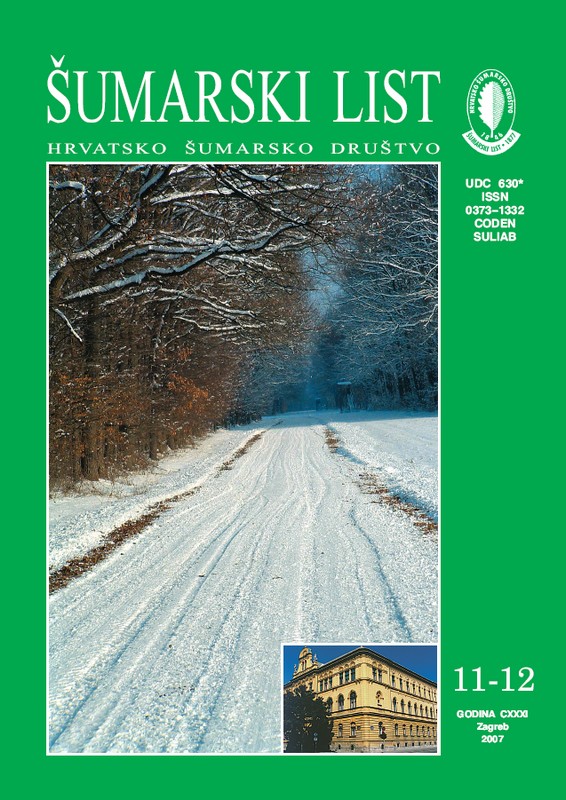
broj: 11-12/2007
pdf (28,4 MB) |
|
||||||||||||||
| IZVORNI ZNANSTVENI ČLANCI | ||
| Pernar, R., M. Ančić, A. Seletković | UDK 630* 429 + 453 (001) | |
| Application of Colour Infrared Aerial Photographs for the Assessment of Forest Damage in the Gospić Forest Administration pdf HR EN | 507 | |
| Kajba, D., N. Pavičić, S. Bogdan, I. Katičić | UDK 630* 165 (001) | |
| Pomotechnical Treatments in the Broadleave Clonal Seed Orchards pdf HR EN | 523 | |
| Ivanković, M. | UDK 630* 165 (001) | |
| Posibility of Genetical Introgresion of Nordmann fir (Abies nordmaniana /Steven/ Spach) in Common Fir Forests (Abies alba Mill.) of Macelj and Trakošćan pdf HR EN | 529 | |
| PREGLEDNI ČLANCI | ||
| Margaletić, J., V. Jurjević, M. Glavaš, B. Hrašovec, D. Diminić | UDK 630* 453 | |
| The Analises Extermination of Gypsy Moth (Lymantria dispar L.) in the 2005 Year of Croatian State Forests pdf HR EN | 539 | |
| Summary: The gypsy moth (Lymantria dispar L.) is a polyphagous pest that in the caterpillar stage causes defoliation (eating leaves) on the following tree species: common oak (Quercus robur L.), European hornbeam (Carpinus betulus L.), poplars (Populus spp.) willows (Salix spp.), alders (Alnus spp.), plums (Prunus spp.), apples (Malus spp.) and others. At the time of massive appearances, they can damage tree leaves over a large area. In the past 60 years, several large gradations of this type were recorded in the following periods: 1945–1950, 1953–1956, 1963–1967, 1969–1975 and 2002–2005. Defoliation damage is manifested in the reduction of the growth interval and the lack of fruit. In the case of total defoliation, the growth interval can be reduced up to 30%. In the event that the leaves appearing after defoliation are destroyed by the powdery oak mildew (Microsphaera alphitoides Griff. et Maubl.), it has been established that the reduction of the growth interval is even greater, thereby creating the conditions for massive forest drying. Forest protection tasks, one of the core activities of the state-held company Croatian Forests d.o.o. Zagreb, are organized in a three tier system (Direction, District forest management, forest district), in which each level has clearly defined tasks as prescribed by the Forests Act, the Plant Protection Act, the Fire Protection Act, general company acts and a series of other laws and by-laws. Assessments of the abundance of the gypsy moth in the forests of Croatia have been carried out by determining the abundance of egg masses along a diagonal line laid down in the forest stand. The intensity of representation is divided into five degrees depending on the percentage of trees on which egg masses are recorded. In 2002, the presence of the gypsy moth was recorded of varying intensity on 58,458 ha of forest, in 2003 on 84,409.56 ha, and in 2004 on 149,153.39 ha. Based on the abundance assessment for autumn 2004, the assumption was that the abundance of this species was expected to rise in spring 2005, and protection measures were organized on an overall area of 31,304 ha of forests managed by the District Forest Managements of Vinkovci, Osijek, Našice, Zagreb, Sisak and Nova Gradiška. Controlling actions included the following activities: determining the areas for control, determining the method of control, preparing maps with areas where the pest was recorded, determining the type of insecticide to be used and procuring the same, determining the airport to be used, ensuring a sufficient number of transport vehicles for the supply of insecticide and personnel to the airport and informing the public (particularly bee-keepers) of the time of implementing the activities. The decision to use certain substances was made based on the following criteria: percentage of trees where egg batches were recorded (intensity of the “attack”), status of individual stands (whether they lie in a protected area or not), the available quantity of all types of protective measures, meteorological conditions, technical aircraft equipment and a study of caterpillar development. Pursuant to these criteria, the following substances were used to control gypsy moths in 2005: Foray 48 B (22,311 l), Match 050 EC (6,229 l), Karate 2.5 EC (2,525 l), Decis 2.5 EC (884 l) and Dimilin SC 48 (210 l). Based on the price of the substance, its consumption per unit area (ha) and the aircraft costs, the control costs per unit area by substance were: 488 HRK/ha (Foray 48 B); 234 HRK/ha (Match 0.5 EC); 242 HRK/ha (Dimilin SC 48); 106 HRK/ha (Decis 2.5 EC) and 99 HRK/ha (Karate 2.5 EC). The costs of controlling gypsy moth during 2005 (the total of all treated areas in the Republic of Croatia) totalled 6,106,190 HRK or an average of 195.06 HRK/ha, regardless of the type of substance used. To determine the success of the control measures, visual observation and the method of setting up control plates were used. Key words: defoliation; forest ecosystem; forest protection.; gypsy moth (Lymantria dispar L.); insecticides; oak (Quercus robur L.); population dynamics | ||
| Dasović, M. | UDK 630* 907.1 + 907.2 : 652 | |
| Biological-Ekological and Spatial Evaluation of “Laudonov Gaj” Park Forest PDF | 549 | |
| STRUČNI ČLANCI | ||
| Nikolandić, Đ., D. Degmečić | UDK 630* 156 | |
| Recruitment Rate of the Roe Deer (Capreolus capreolus L.) in Baranja Forests pdf HR EN | 565 | |


